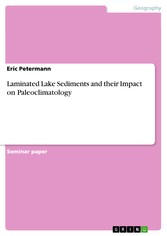Search and Find
Service
Laminated Lake Sediments and their Impact on Paleoclimatology
Seminar paper from the year 2008 in the subject Geography / Earth Science - Geology, Mineralogy, Soil Science, grade: 1,0, University of Canterbury (Department of Geology), course: Paleoecology and Paleolimnology, language: English, abstract: Zolitschka (1998) defined varves as laminated sediments occurring in stationary water bodies. Their striking feature is a seasonal, rhythmical build-up of thin, horizontal layers with a changing composition. Since the early 20th century, this type of sediment has been used for establishing exact geochronologies. In the course of the climate change debate, and the subsequent demand for high-resolution paleoclimatic data, they have come back into the focus of earth scientists. A crucial advantage of varved sediments is that they provide two different kinds of information on a sediment profile: an absolute chronology and high-resolution paleoclimatic information. Combining these two attributes offers an absolute dated time series of paleoclimatic proxy-data. Furthermore, additional analyses of the same profile can be dated. Varved sediments can be found in recent lakes as well as in paleolakes. However, their occurrence is limited to only a few sites as a consequence of the special circumstances necessary for their generation. Varved sediments in recent lakes are especially found in lakes, which are small and deep. These preconditions are often met by maars, where a lot of investigations are done (Brauer et al. 1999a, 1999b; Litt et al. 2001). Additionally, varved sediments are even found in ancient proglacial lakes (Moscariello et al. 2000) to give an example.
All prices incl. VAT













